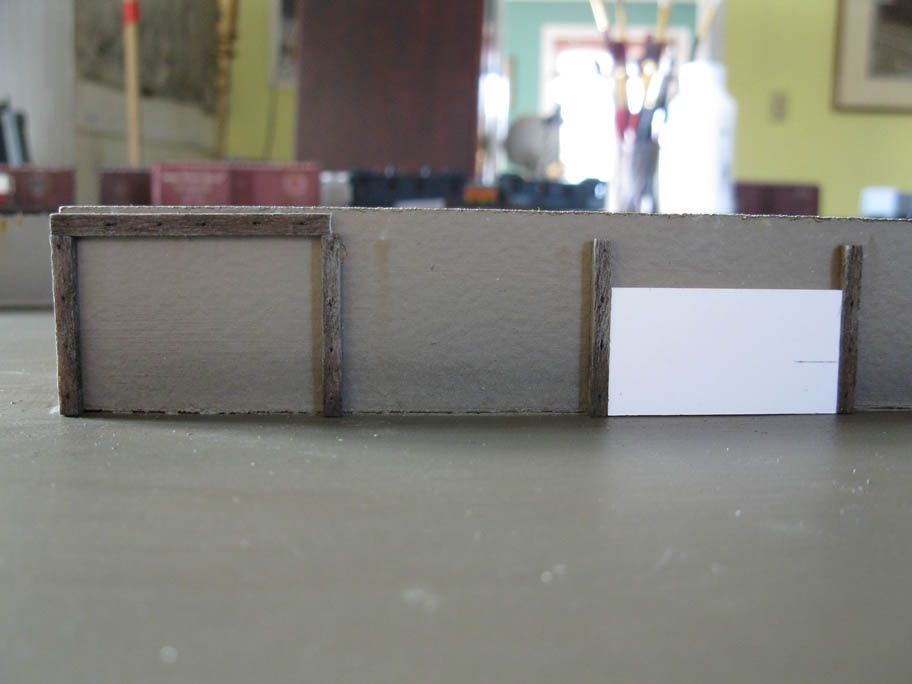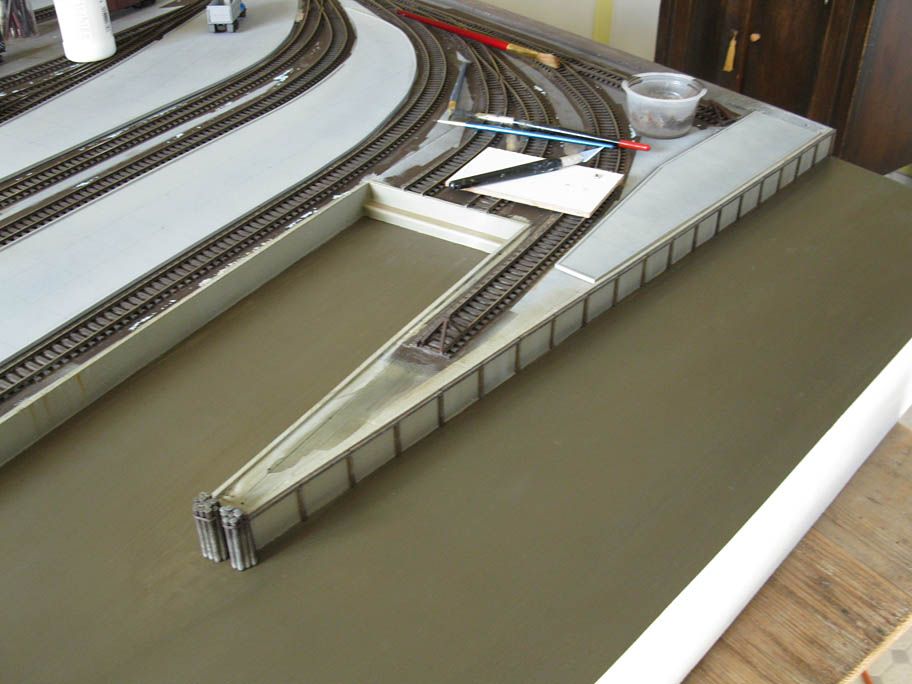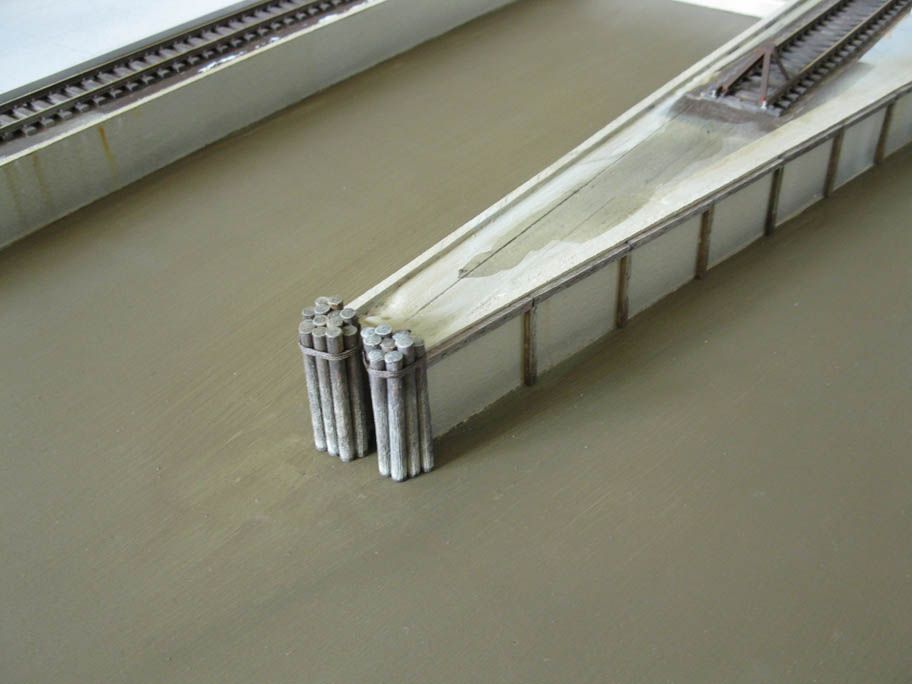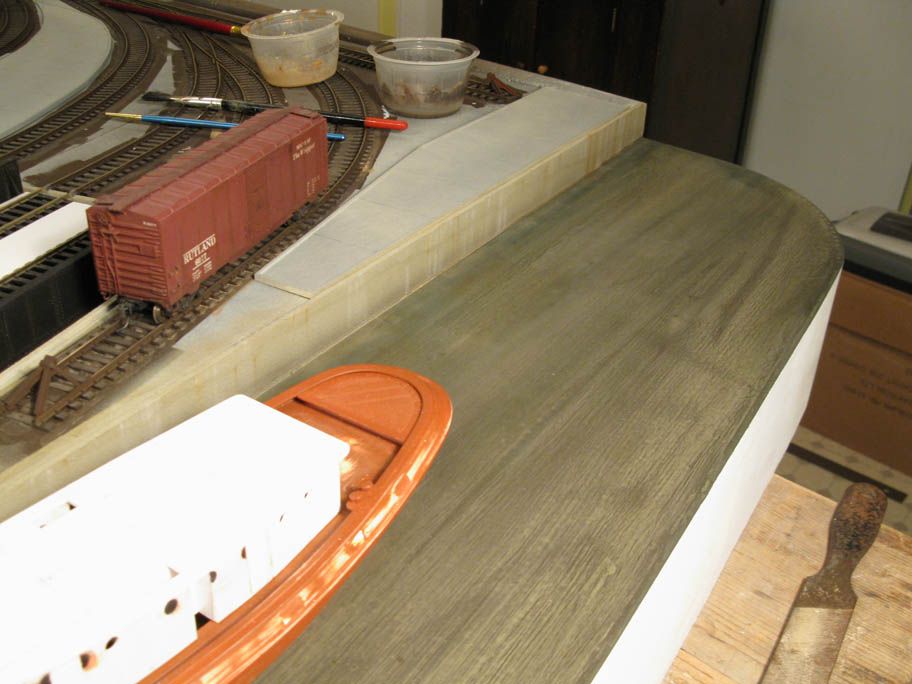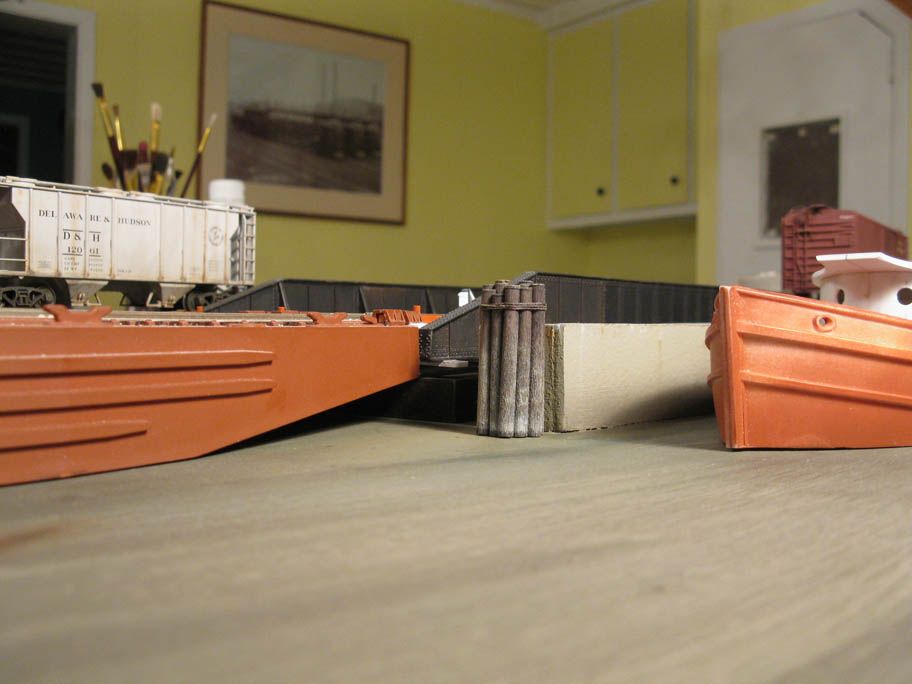I finally tackled the time-consuming task of adding a wood deck on the float bridge today.
I don't know what took the most time, but cutting, staining and gluing all the individual planks took 6 hours non-stop. At least, it was quite relaxing and enjoyable, far beyond my expectation.
Before gluing the planks, I was required to glue a 0.5 mm thick styrene sheet over my original deck to get a flat top flush with the rail spikes.
Wood planks, made of balsa, were stained with a mix of India ink and alcohol. Color pictures of the 50s show that the bridge planking was relatively new and not totally greyish. Using alcohol was a safe bet to get that look.
The next step will be to further weather the planking according to prototype. Oil spills from locomotives were quite impressive!
Saturday, 26 December 2015
Wednesday, 23 December 2015
Bridging the Gap
Sometimes, solutions are easier than first envisionned.
Last week, we tackled the problem of electrifying the carfloat and the float bridge. The answer was to run feeders from beneath to every stock rail.
The carfloat required I drill small holes against the rail to insert the feeders. Once putty and paint completed, it should be barely noticeable.
The wires were then connected together under the carfloat sloping hull. This part is invisible when the float is on the layout, so we didn't bother making it fancier than required. A male connector will make it possible to plug the carfloat on the layout bus wires. More about that later.
Feeding the float bridge required a little bit more ingenuity. My main concern was that the bridge could be removed anytime and wouldn't be directly connected with the main layout trackage. Using rail joiners wasn't an option to me. We thus decided to feed the rails with small copper wires soldered on each rail ends. Near the turnout, it meant the wire made a loop connected to insulated wire.
Once again, a male connector was also soldered to the bridge wires to make it plug-and-play. Since we don't plan to use the layout without the carfloat, all wires are visually hidden under normal circumstances. A little paint will make them disappear.
As you can see, when seen from top, you can hardly think all this wiring is running under the structures. You can also notice I added Frenchman River Models float bridge mechanism. Quite easy to put together and bring a lot of life to the model.
Finally, we soldered a pair of female connector on feeder wires. A hole will be drilled behind the pontoon and feeders will be soldered to bus wire in a traditional way. The carfloat and float bridge will then be plugged on it.
Last week, we tackled the problem of electrifying the carfloat and the float bridge. The answer was to run feeders from beneath to every stock rail.
The carfloat required I drill small holes against the rail to insert the feeders. Once putty and paint completed, it should be barely noticeable.
The wires were then connected together under the carfloat sloping hull. This part is invisible when the float is on the layout, so we didn't bother making it fancier than required. A male connector will make it possible to plug the carfloat on the layout bus wires. More about that later.
Feeding the float bridge required a little bit more ingenuity. My main concern was that the bridge could be removed anytime and wouldn't be directly connected with the main layout trackage. Using rail joiners wasn't an option to me. We thus decided to feed the rails with small copper wires soldered on each rail ends. Near the turnout, it meant the wire made a loop connected to insulated wire.
Once again, a male connector was also soldered to the bridge wires to make it plug-and-play. Since we don't plan to use the layout without the carfloat, all wires are visually hidden under normal circumstances. A little paint will make them disappear.
As you can see, when seen from top, you can hardly think all this wiring is running under the structures. You can also notice I added Frenchman River Models float bridge mechanism. Quite easy to put together and bring a lot of life to the model.
Finally, we soldered a pair of female connector on feeder wires. A hole will be drilled behind the pontoon and feeders will be soldered to bus wire in a traditional way. The carfloat and float bridge will then be plugged on it.
Tuesday, 22 December 2015
Some progress? Yes!
It's always crazy to discover how much interest this project is gathering. New York City rail-marine terminals are truly a dear child of this hobby.
I didn't update the blog over the last months because my energies were focussed on my other project: Hedley-Junction.
However, I did some work on the layout, including some painting and wiring. The layout was initially designed to be battery-operated. But financial and technical constrains put a end to that adventure. It will be DC powered with a possibility to be converted easily to DCC.
We actually have wired the carfloat and float bridge in such a way a locomotive will be able to travel EVERYWHERE. You read me well, everywhere. Old pictures of Harlem Station show no idle cars were used and the locomotives ventured onto the carfloat. We will reproduce that while operating the layout.
I don't know if I'll be able to push detailing and scenery work as far I first hoped, but the layout will be soon delivered to Jérôme, the final end user. So far, he's been extremely satisfied with what he have seen and no wonder why. He's an operation fan and I feel this layout will fit his needs perfectly.
I didn't update the blog over the last months because my energies were focussed on my other project: Hedley-Junction.
However, I did some work on the layout, including some painting and wiring. The layout was initially designed to be battery-operated. But financial and technical constrains put a end to that adventure. It will be DC powered with a possibility to be converted easily to DCC.
We actually have wired the carfloat and float bridge in such a way a locomotive will be able to travel EVERYWHERE. You read me well, everywhere. Old pictures of Harlem Station show no idle cars were used and the locomotives ventured onto the carfloat. We will reproduce that while operating the layout.
I don't know if I'll be able to push detailing and scenery work as far I first hoped, but the layout will be soon delivered to Jérôme, the final end user. So far, he's been extremely satisfied with what he have seen and no wonder why. He's an operation fan and I feel this layout will fit his needs perfectly.
Sunday, 9 August 2015
Ground Cover Over
Mark this day as it is the first time in 2 decades I ever complete ballast and ground cover on any layout I ever built.
Ballast is a mix of various dirt, sand, sandblasting sand and charcoal. It's only a starting point as I'll have to adjust coloration here and there with washes, pastel powders and various material. Harlem Station was a very dirty place to be. Some weeds will also be needed here and there.
Ballast is a mix of various dirt, sand, sandblasting sand and charcoal. It's only a starting point as I'll have to adjust coloration here and there with washes, pastel powders and various material. Harlem Station was a very dirty place to be. Some weeds will also be needed here and there.
Friday, 7 August 2015
Landmark
Lot of stuff happened during the last two days. I won't waste my time struggling with futile words.
First, I painted the carfloat. After a basic coat of Krylon camouflage brown, I decided to try a method I once heard but never really applied. Instead of building the weathering pattern with several layers, I just used heavy washes of cheap acrylic paint including burnt umber, burnt sienna, Payne's grey and yellow ochre. Those water-based washes were really liquid and I dabbed and stippled thinned paint here and there. The idea was that those "floating" colors would merge together instead of drying. Some colors pool here and there. The nice thing is that the puddles leaves a very realistic weathering pattern. So far, I did the operation 3 times. I plan to lighten the overall color a little bit again with more drastic contrasts. I was once told in my teenage years that my drawing skills were good but that I was too shy to add light and shadows. Since then, I try to fight that natural tendency! With little success! Other weathering technics will be used, but I feel this technic is worth using. Very fool proof, no real talent needed, physic laws do the job for you.
Next project was to build the iconic Erie bridge crane (not sure it's the good name for that thing). Getting the thing right was very important because this crane is visible and easily recognizeable on every Harlem Station pictures. That's the mascot! I used Central Valley bridge parts. Well, I completely depleted my stock and had to butcher my CNR Courtesy and Service bridge! Oh well, you can start throwing rotten tomatoes! Wood used was custom cut cedar patio planking leftover from my last week home improvement project. I stained the wood with tea and coated them with my steel wool/peroxyde mix. The mix is now more than a week old and works even better. The black painting was done with India ink and alcohol. The "Erie" lettering was drawn to scale from picture. This is the REAL thing, not some "quite similar" font. I printed them on Walthers decal paper, coated with dullcote. My first try was a few years ago when I did my QRL&PCo gondolas and hoppers. Back then, I used Krylon flat finish and the decals ended very thick and hard to work. With dullcote, they stay very thin. That's the way to go. Still a long way to go before this crane is completed, but the basic work is now done.
Finally, I also started to ballast tracks with several material taken in the backyard: sand, dirt and some wood coal. My first mix add too much fine powder. It really makes it hard to glue. I finally decided to resift the dirt several time outside in the wind to get rid of the fine particles and keep the rocks.
First, I painted the carfloat. After a basic coat of Krylon camouflage brown, I decided to try a method I once heard but never really applied. Instead of building the weathering pattern with several layers, I just used heavy washes of cheap acrylic paint including burnt umber, burnt sienna, Payne's grey and yellow ochre. Those water-based washes were really liquid and I dabbed and stippled thinned paint here and there. The idea was that those "floating" colors would merge together instead of drying. Some colors pool here and there. The nice thing is that the puddles leaves a very realistic weathering pattern. So far, I did the operation 3 times. I plan to lighten the overall color a little bit again with more drastic contrasts. I was once told in my teenage years that my drawing skills were good but that I was too shy to add light and shadows. Since then, I try to fight that natural tendency! With little success! Other weathering technics will be used, but I feel this technic is worth using. Very fool proof, no real talent needed, physic laws do the job for you.
Next project was to build the iconic Erie bridge crane (not sure it's the good name for that thing). Getting the thing right was very important because this crane is visible and easily recognizeable on every Harlem Station pictures. That's the mascot! I used Central Valley bridge parts. Well, I completely depleted my stock and had to butcher my CNR Courtesy and Service bridge! Oh well, you can start throwing rotten tomatoes! Wood used was custom cut cedar patio planking leftover from my last week home improvement project. I stained the wood with tea and coated them with my steel wool/peroxyde mix. The mix is now more than a week old and works even better. The black painting was done with India ink and alcohol. The "Erie" lettering was drawn to scale from picture. This is the REAL thing, not some "quite similar" font. I printed them on Walthers decal paper, coated with dullcote. My first try was a few years ago when I did my QRL&PCo gondolas and hoppers. Back then, I used Krylon flat finish and the decals ended very thick and hard to work. With dullcote, they stay very thin. That's the way to go. Still a long way to go before this crane is completed, but the basic work is now done.
Finally, I also started to ballast tracks with several material taken in the backyard: sand, dirt and some wood coal. My first mix add too much fine powder. It really makes it hard to glue. I finally decided to resift the dirt several time outside in the wind to get rid of the fine particles and keep the rocks.
Wednesday, 5 August 2015
Harlem River Waters
A few days ago, I decided to complete the water body. It's my first time modelling water even if I've been doing model railroading for over 25 years now. Harlem River waters are your
typical greyish/brownish color found on any urban setting According to pictures, the surface is moderatly rippled.
The first step was to add the bridge pontoon. It's basically a block of MDF. I rusted it using acrylics and cosmetic sponges. These work wonders. I started by applying a base coat color mixed with chocolate brown and green. When dry, I airbrushed the seawalls base with a mist of alcohol and India ink. I made sure the water near the walls was darker to give the impression waters are deep there.
Next step was to apply acrylic gloss medium gel. After a few minutes, when starting to get thicker, I dabbled the surface to create the ripple. A lot of air bubbles got trapped into the mix and it was really annoying to remove them. It wasn't perfect, but still decent. The next morning, another coat was added and dabbled. For this second coat, I added some acrylic paint to the medium to get a darker shade of my base color. I used it to create shadows on the water. I often saw that kind of shadow when St. Lawrence river's waters are muddy. Some highly were also added and I dramatized the shadow near the walls.
Finally, today, I added two coats of Future Floor finish. I heavily diluted Citadel washes to make this layer muddy. It really helped to subdue my crude painted shadows. They are quite cartoony I must say. At least, when the tug and carfloat are there, it looks better. I'm aware it could be better, but show must go on. I have to fit against my improductive perfectionnist state of mind for once. Anyway, the layout is already beyond Jérôme's expectations.
I also built concrete walls with cardboard. These will surround the property on 148th Street and Exterior Street. They were painted with Krylon flat camouflage beige then weathered liberally with oil paints. When dry, I dullcoted them. I love those easy technics, they really bring life to the most generic structures.
The carfloat is also getting a coat of paint and rust. More to come.
Tuesday, 28 July 2015
More pier details...
Some more wood details added this morning. Next step is to complete the
pontoon and secure it in place permanently. After, the last weathering
will be done before adding the acrylic gloss medium.
Monday, 27 July 2015
Detailing Concrete Piers
I did some work yesterday, mainly painting and weathering the concrete
piers and making wooden pilings. I did another bunch of pilings today. I
use wooden stick used to light candlelight in churches. Many years ago,
when I worked at a shrine, a brother gave me quite a bunch of them for
modelling purpose. They are about 2.5mm diameter, so they are useful for
many things (utility poles, etc.).
To weather the wood, I tried a technic called ebonizing. You apply tea to wood, let it dry, them apply a solution of steel wool/peroxide. Most people use vinegar, but peroxide dissolve the steel wool faster (in a matter of minutes instead of days). It reacts with wood (and tea) tannings by oxidizing them in a nice grey color. If you add too much, it will turn almost black. I made two application and drybrushed a buff color paint to make wood grain pop up. This was also a good way to replicate real wooden pilings color gradient. The famous CPR carfloat in Rosebery, BC was used as prototype to make sure the weathering pattern was realistic.
Next step is to paint water. It was supposed to be done today, but weather was quite nice and I decided it was the best time to replace my veranda's wood planking. Lots of rain in the upcoming days, so it will be perfect for modelling. For the water, I'm thinking using a greenish/brown - kind of varech color - then apply several layers of acrylic gloss medium to add ripples.
To weather the wood, I tried a technic called ebonizing. You apply tea to wood, let it dry, them apply a solution of steel wool/peroxide. Most people use vinegar, but peroxide dissolve the steel wool faster (in a matter of minutes instead of days). It reacts with wood (and tea) tannings by oxidizing them in a nice grey color. If you add too much, it will turn almost black. I made two application and drybrushed a buff color paint to make wood grain pop up. This was also a good way to replicate real wooden pilings color gradient. The famous CPR carfloat in Rosebery, BC was used as prototype to make sure the weathering pattern was realistic.
Next step is to paint water. It was supposed to be done today, but weather was quite nice and I decided it was the best time to replace my veranda's wood planking. Lots of rain in the upcoming days, so it will be perfect for modelling. For the water, I'm thinking using a greenish/brown - kind of varech color - then apply several layers of acrylic gloss medium to add ripples.
Saturday, 25 July 2015
Reaching Your Goals
I gave myself two weeks to complete this project. The deadline was my own vacations. I'm glad to tell you I reach this step in a week. At a rate of 8 to 12 hours per day, it moved at a steady pace.
I consider I have now completed all the messy basic stuff including painting track and roads in basic colors. To me, this is a true achievement. Thought I started to build many layouts in my life - probably over 20 - this is the second time I reach that point where only building structures, scenery and detail cars remain. The first time was when I was 7 years old and I built my first 4' x 4' train layout with my father, sister and brother. Good to be back on track after a 25 years hiatus! Seriously, never reaching some level of achievement can be quite distressing at some point.
I've learned a few things bout myself while doing this project. I didn't over design the project, but took a decent amount of time to plan carefully the project. When I started to rip wood, I knew there was no turning point and decided to address issues as they appeared. I didn't let small things stop the project and thought about alternate way to get the job done in due time. I was ready to sacrifice my obsession for perfection which had always been my most major pitfall. Funnily, I can't say I cut corners on quality as the final product is quite good. Finally, I didn't set a real schedule but each time I started a job, I made a point I would complete it on the same day if possible. That was particularly important to get over boring or painstaking work.
So, what has been achieved today? Well, all the roads were painted. I became lazy and decided to give a try at Lance Mindheim spray can technic using grey primer. I didn't try to get a solid color but instead tried to keep some transparencies here and there to get color variation. The cardboard I used had a very nice color from the start. With what remained of my last can of Krylon Satin River Rock, I highlighted the concrete curbs and some other spots. It was merely a mist but it did improve the general look.
Next, I spray a good coat of Dullcote before airbrushing a mix of India ink and isopropyl alcohol to give some wear and depth. When dry, I draw the concrete slab lines with a black color pencil. It may sound childish, but it really gave a lot of details with too much effort. It was also a good way to hide the unsightly real seams in my roads. Concrete slabs follow a rough 12 feet x 12 feet grid. I followed U.S. Highway practices from the 20s and 30s.
Finally, the last step was to add cracks here and there to represent old concrete slabs. I particularly detailed the grade crossing where a lot of stress is exerted by trucks and trains.
The most rewarding moment was when all the masking tape was removed and american cars were added to the scene. We can already have a good idea of the final product. Better, some scenes are instantly recognizable from old prototype pictures of Harlem Station. Oh, I didn't remember I had so much old U.S. cars. Lots of fun detailing projects in sight!
The most urgent matter is to build a battery powered locomotives and operate the layout!
And now a few railfan shots!
Subscribe to:
Posts (Atom)













































